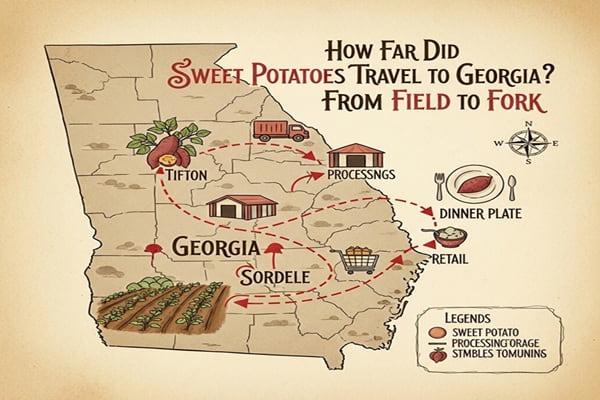Sweet potatoes aren’t just a side dish on the holiday table—they’re a piece of history, a nutritional powerhouse, and a cultural staple in Georgia and across the South. These bright, earthy tubers carry a story that stretches back thousands of years, crossing continents and cultures before becoming a beloved part of Georgia’s farms and kitchens.
But how far did sweet potatoes travel to Georgia? And what makes them so important to southern cuisine today? Let’s take a journey through time and taste to discover their remarkable story.
1. Ancient Roots: Where Sweet Potatoes Really Came From
Sweet potatoes go way back—more than 5,000 years ago, they were already thriving in Central and South America. Indigenous peoples cultivated them not only as food but also for medicinal purposes. Ancient civilizations like the Incas and Mayans revered sweet potatoes as reliable sources of energy and nutrition.
When you think of sweet potatoes today—mashed, roasted, or baked into pies—it’s incredible to remember that these same roots once fueled empires.
Key takeaway: Sweet potatoes didn’t just pop up in Georgia’s soil; they’ve traveled across time and geography to get there.
2. The Global Journey: From the Americas to Europe and Beyond
The sweet potato’s global adventure began in the late 15th century with the Columbian Exchange—the massive trade of crops, animals, and ideas between the Old World and the New. Spanish explorers carried sweet potatoes back to Europe, where they quickly became a curiosity and, eventually, a staple food.
From there, sweet potatoes made their way across Africa and Asia, adapting to different climates and cuisines. They were celebrated for their versatility, resilience, and, of course, their natural sweetness.
By the time European settlers were exploring North America, sweet potatoes had already circled the globe.
3. Finding a Home in Georgia’s Soil
So how did sweet potatoes land in Georgia? The story begins with Spanish explorers, who introduced the crop to the American South in the 16th century. By the early 1700s, Georgia’s warm climate and fertile soil made it an ideal environment for cultivating sweet potatoes.
Farmers quickly embraced the tuber as both a reliable crop and a delicious addition to their tables. As word spread about their adaptability and nutrition, sweet potatoes became woven into the very fabric of southern agriculture and cuisine.
Why Georgia loves sweet potatoes:
-
Perfect growing conditions (long summers and rich soil).
-
High yield and reliable harvests.
-
Versatility in both savory and sweet recipes.
4. From Field to Fork: The Sweet Potato’s Journey Today
Sweet potatoes don’t just appear in your grocery store—they go through an incredible journey before hitting your plate.
-
Cultivation: Farmers plant sweet potatoes in Georgia’s sandy soil, giving them ample sun and just the right amount of water.
-
Harvest: Once mature, they’re carefully dug up to preserve their delicate skins.
-
Curing: To enhance sweetness and extend shelf life, sweet potatoes are cured in warm, humid conditions for several days.
-
Sorting and packaging: Farmers clean and sort them by size and quality before sending them to markets.
-
Distribution: Some stay local—sold in farmers’ markets and small stores—while others travel across the U.S. and beyond.
From farm to table, each sweet potato reflects Georgia’s agricultural traditions and commitment to quality.
5. Sweet Potatoes on the Plate: Georgia’s Favorite Recipes
Ask any Georgian about sweet potatoes, and you’ll hear about more than just one dish. These versatile tubers star in both comfort food and gourmet creations.
-
Sweet Potato Pie: The crown jewel of southern desserts, filled with cinnamon, nutmeg, and creamy sweet potato goodness.
-
Sweet Potato Casserole: A holiday staple topped with either marshmallows for sweetness or pecans for a nutty crunch.
-
Fried Sweet Potato Chips: Crispy, golden snacks perfect for dipping.
-
Creamy Sweet Potato Soup: Comfort in a bowl, perfect for chilly evenings.
-
Roasted Sweet Potatoes: Simply seasoned and baked, they’re the side dish that goes with everything.
Sweet potatoes also sneak into breads, muffins, pancakes, and even cocktails in some southern kitchens.
6. Health Benefits That Go Beyond Flavor
Sweet potatoes aren’t just delicious—they’re seriously good for you. Here’s why nutritionists rave about them:
-
Rich in beta-carotene (Vitamin A): Essential for eye health and a strong immune system.
-
Packed with fiber: Supports digestion and helps regulate blood sugar levels.
-
Antioxidants galore: Combat oxidative stress and inflammation.
-
Complex carbs: Provide sustained energy without blood sugar spikes.
-
Vitamins & minerals: From Vitamin C to potassium, they’re nutrient-dense powerhouses.
Whether you’re eating them baked or blended into soup, sweet potatoes fuel your body in a healthy, sustainable way.
Also Read : How Many People Can You Take on a Rented Yacht?
7. Sweet Potatoes and Sustainability
Here’s another reason to love sweet potatoes: they’re one of the most sustainable crops around.
-
Low resource needs: They thrive with less water and fewer fertilizers than many crops.
-
Soil health: Their deep roots prevent erosion and improve soil quality.
-
Pest resistance: Naturally resilient, they require fewer pesticides.
-
Local farming: Supporting Georgia-grown sweet potatoes means fewer transportation emissions and stronger local economies.
By choosing sweet potatoes, you’re not just enjoying great flavor—you’re also supporting environmentally friendly agriculture.
The Legacy of Sweet Potatoes in Georgia
From ancient South American fields to Georgia’s rich farmlands, sweet potatoes have made an incredible journey. They’ve fed civilizations, crossed oceans, and rooted themselves deeply in southern identity.
In Georgia, they’re more than food—they’re part of holiday traditions, family recipes, and local pride. They bring people together around the table while promoting health and sustainability.
So, the next time you enjoy a slice of sweet potato pie or a roasted wedge, remember: you’re tasting history, culture, and community in every bite.





